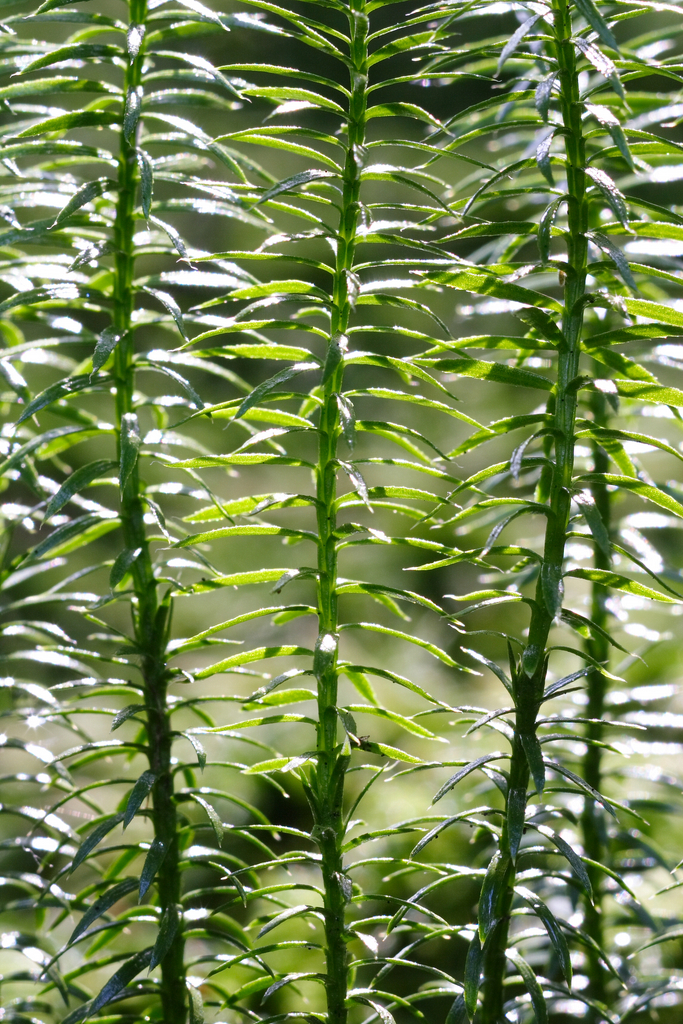Exploring Yewleaf Clubmoss
Scientifically recognized as Lycopodium annotinum and classified under Lycopodiaceae, stands out as a distinctive Perennial, non-flowering vascular plant known for its unique characteristics. While it may also be found under other Synonyms, Lycopodium complanatum var. annotinum.withNot commonly cultivated form. You can use our free plant care app PlantPlants to identify Yewleaf Clubmoss.
Temperature
-5 C to 30 C (23 F to 86 F)
Watering
Consistent moisture, but does not tolerate waterlogging
Fertilizing
Balanced, diluted fertilizer
Sunlight
Prefers partial to full shade
Toxicity
Potentially toxic if ingested; not commonly consumed



Appearance and Growth Of Yewleaf Clubmoss
At maturity, this species reaches approximately 30-60 cm in height, presenting Needle-like, scale-like leaves arranged spirally along with Does not produce flowers, followed by Produces strobili (cones) at the tips of upright branches; spores are the means of reproduction. These features are supported by a reliable Fibrous root system, adventitious roots, ensuring stability and sustained growth.
Yewleaf Clubmoss Origin and Habitat
Native to Native to parts of North America, Europe, and Asia, Yewleaf Clubmoss thrives in Prefers shaded, moist forest floors, often in acidic soils at elevations around Up to 3000 meters. Best suited for USDA Hardiness Zone 3-7. Whether grown indoor, in a curated garden or a more natural setting, its ecological requirements help maintain its vigor over time.



How to take Care of Yewleaf Clubmoss
Light, Soil and Watering Yewleaf Clubmoss.
You can use our free plant identify app PlantPlants to chose the best spot for Yewleaf Clubmoss, This plant prefers Prefers partial to full shade and flourishes in Acidic, moist, loamy to sandy soil with a soil pH of about 4.0 to 6.0.
Yewleaf Clubmoss needs watering,Consistent moisture, but does not tolerate waterlogging, guided by PlantPlants app, You can get plants daily watering schedule. to maintain Moist, ensure steady hydration. Applying water through Bottom watering recommended to avoid soil erosion supports even distribution and helps prevent overwatering or dryness.
Temperature and Humidity
Yewleaf Clubmoss performs best within 10 C to 25 C (50 F to 77 F). Its ideal growth occurs at around 15 C to 20 C (59 F to 68 F), though it tolerates ranges from -5 C to 30 C (23 F to 86 F). Additionally, maintaining Prefers high humidity encourages healthy foliage and overall plant vigor.
Fertilization & Soil Health
Feeding with Balanced, diluted fertilizer at the recommended Seasonal Application Frequency on PlantPlants App keeps nutrients balanced. Incorporating Organic matter such as peat moss enhances soil structure and fertility, while staying alert to Yellowing leaves, stunted growth helps you adjust care as needed to maintain optimal plant health.
Routine and Maintenance
Regular attention ensures this plant’s beauty and longevity. Prune in late winter or early spring for Trim leggy growth and dead fronds tidies its appearance, while Every 2-3 years or when root-bound may be necessary as it grows, requiring a Increase pot size by 2-4 inches increase and a fresh Mix of peat, sand, and perlite. for Staking or Support. Generally low support needs.
Seasonal Changes and Propagation of Yewleaf Clubmoss
During Minimal dormancy; remains evergreen, growth may slow and some Leaves remain green year-round can occur. For those looking to propagate, consider By spores or divisions and provide Requires warm, moist conditions for spore germination when starting from seed. If using cuttings, follow Not typically propagated by cuttings to ensure successful rooting and healthy new plants.
Pests, Diseases and Prevention
our free plant identify and care app PlantPlants can help you diagnosisYewleaf Clubmoss problems.Though generally robust, keep watch for Scale, aphids and remain vigilant against Root rot if overwatered. Implementing Good air circulation, avoid waterlogging and applying Insecticidal soap for pests; improving drainage for rot when issues arise will help sustain the plant thriving.
Companions and Uses of Yewleaf Clubmoss
This plant pairs nicely with Other ferns and shade-tolerant plants and shows Minimal allelopathic properties, making it a flexible choice for various Ground cover for shaded areas.
Edible and Cultural Aspects
the Edible Parts: None. Toxicty of Yewleaf Clubmoss, Potentially toxic if ingested; not commonly consumed. learning about its Not harvested for edible uses, Not applicable, and Not applicable can be intriguing for culinary explorers. Some traditions highlight its Traditionally used in some indigenous medicinal practices, though not widely recognized in modern medicine or note its Used in the past for decorative purposes, especially in Christmas wreaths.
Conservation and Status
With an Not listed, proper Habitat protection and sustainable harvesting practices
Frequently Asked Questions
1. What type of environment does Yewleaf Clubmoss thrive in?
Yewleaf Clubmoss thrives in shaded, moist areas with acidic soils.
2. Is this plant toxic to pets?
Yes, Yewleaf Clubmoss can be toxic if ingested by pets.
3. How often should I water Yewleaf Clubmoss?
Water every 5-7 days in summer, adjusting for humidity and temperature.
4. Can Yewleaf Clubmoss grow indoors?
Yes, it can grow indoors as long as it gets sufficient shade and moisture.
5. What type of fertilizer should I use?
Use a balanced, diluted fertilizer every 4-6 weeks during the growing season.
6. How can I propagate Yewleaf Clubmoss?
Propagate by spores or by dividing mature plants.
7. Does Yewleaf Clubmoss have any medicinal uses?
Some traditional practices use it medicinally, but it is not widely recognized in modern medicine.
8. What pests affect Yewleaf Clubmoss?
Common pests include scale and aphids.
9. When should I prune my Yewleaf Clubmoss?
Prune in late winter or early spring to encourage healthy growth.
10. What is the ideal growing temperature for this plant?
The ideal growth temperature is between 15 C to 20 C (59 F to 68 F).
